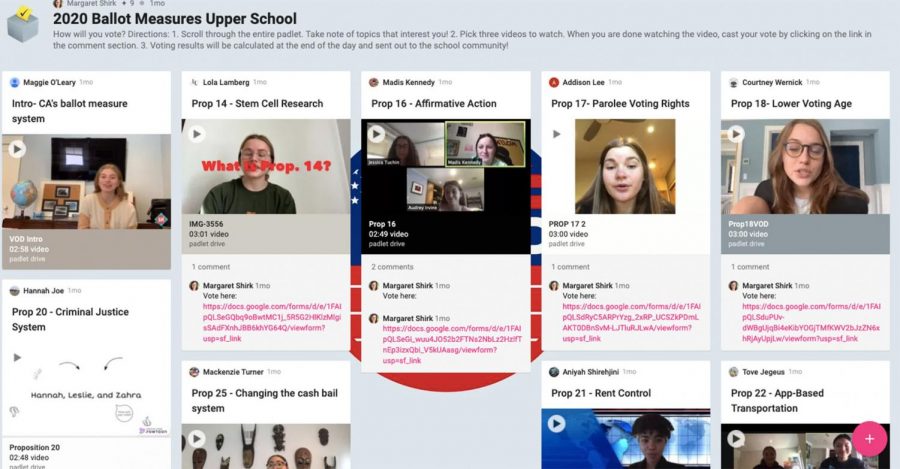Students vote on select California propositions to ‘learn about local politics’ during election season
Photo credit: Grace Doyle
After researching select propositions, students in Margaret Shirk’s Voice of Democracy class put together a Padlet with the pros and cons on their assigned California ballot propositions. Later, the Archer community watched the videos and voted on their preferred local policy.
November 22, 2020
Prior to the presidential election, history teacher Margaret Shirk’s Voice of Democracy class designed a California propositions activity with the goal of engaging the Archer community in California’s specific issues. The Archer community members did a mock vote of eight propositions in parallel with the real vote of Californians and the results were compared after election day.
“We developed this idea collaboratively in the history department,” Shirk wrote in a recent email. “We decided to focus our [Community Connections] presentation on voting rights and we thought that highlighting the ballot measures was a great way for students to learn about local politics and issues.”
Following the Community Connections presentation surrounding proposition voting, a Padlet made by students in the class was released that explained select propositions for which students would vote yes or no on.
“I think it was a really cool way to involve students in the process as well,” senior Leslie Ignacio said. “Since we’re not able to actually vote on this, it was really interesting to just stay informed and learn about what issues matter most to our community.”
The majority of the student body are not of the voting age, however some are making efforts to stay informed and educated.
“It was cool to see that this is in our future and we’re going to have to learn about these things and educate ourselves,” junior Alexandra Marsh said. “We’re not going to have this guide for us, so I think it’s really nice that we’re learning about the importance of the propositions and voting in general.”
Another goal of the individual videos was to help simplify what students were voting on. Each video specified the pro and cons of each proposition.
“I was also looking at the form of information that’s sent out with each proposition and I think a lot of times it’s complicated, and people don’t necessarily understand what the propositions are saying,” Ignacio said. “So I think this tool is super helpful and it’s shown in a way that’s really simple and clear for everyone.”
Of the propositions voted on, some differences between Archer’s results and California’s results were on Prop 16, for Affirmative Action and Prop 21, which entailed voting on rent control. While at Archer both propositions were voted through, in California both were not passed.
“I was surprised that both propositions were defeated,” Shirk said. “I think the Archer community has more socially progressive views than the rest of the state, which would explain why they voted yes, but the state voted no.”
For some students, the results of Archer’s votes compared to California’s votes helped to remind them of the diversity throughout the state.
“We’re such a small and progressive school and I think people don’t always realize how big California is and how different people are,” Marsh said.
Shirk noted that the participation of students and willingness to seek out information regarding ballot measures was just one of the goals of this exercise.
“I hope [students] see the power of their voice in our democratic system,” Shirk wrote. “I also hope they appreciate the complexity of ballot measures and the need to do research in order to make educated decisions when voting.”









